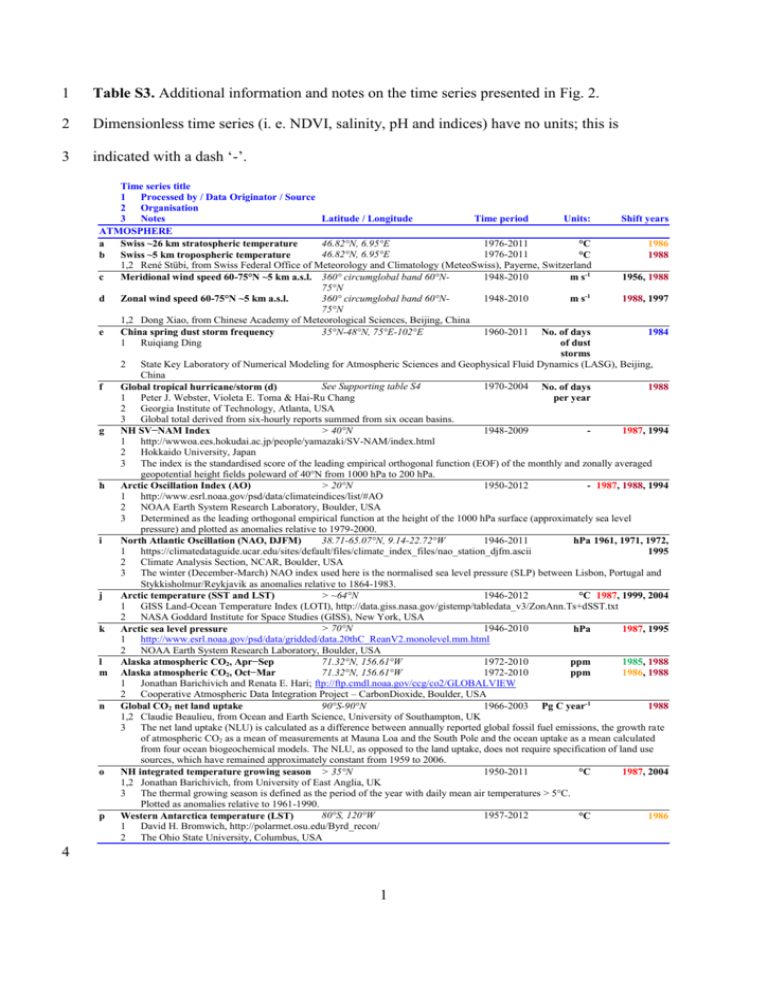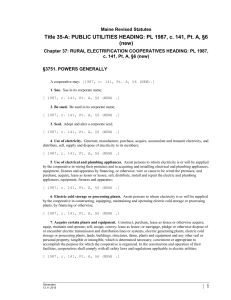gcb13106-sup-0008
advertisement

1 Table S3. Additional information and notes on the time series presented in Fig. 2. 2 Dimensionless time series (i. e. NDVI, salinity, pH and indices) have no units; this is 3 indicated with a dash ‘-’. Time series title 1 Processed by / Data Originator / Source 2 Organisation 3 Notes Latitude / Longitude Time period Units: Shift years ATMOSPHERE 46.82°N, 6.95°E 1976-2011 a Swiss ~26 km stratospheric temperature °C 1986 46.82°N, 6.95°E 1976-2011 b Swiss ~5 km tropospheric temperature °C 1988 1,2 René Stübi, from Swiss Federal Office of Meteorology and Climatology (MeteoSwiss), Payerne, Switzerland 1948-2010 c Meridional wind speed 60-75°N ~5 km a.s.l. 360° circumglobal band 60°Nm s-1 1956, 1988 75°N 360° circumglobal band 60°N1948-2010 d Zonal wind speed 60-75°N ~5 km a.s.l. m s-1 1988, 1997 75°N 1,2 Dong Xiao, from Chinese Academy of Meteorological Sciences, Beijing, China 35°N-48°N, 75°E-102°E 1960-2011 No. of days e China spring dust storm frequency 1984 1 Ruiqiang Ding of dust storms 2 State Key Laboratory of Numerical Modeling for Atmospheric Sciences and Geophysical Fluid Dynamics (LASG), Beijing, China See Supporting table S4 1970-2004 No. of days f Global tropical hurricane/storm (d) 1988 1 Peter J. Webster, Violeta E. Toma & Hai-Ru Chang per year 2 Georgia Institute of Technology, Atlanta, USA 3 Global total derived from six-hourly reports summed from six ocean basins. > 40°N 1948-2009 g NH SV−NAM Index 1987, 1994 1 http://wwwoa.ees.hokudai.ac.jp/people/yamazaki/SV-NAM/index.html 2 Hokkaido University, Japan 3 The index is the standardised score of the leading empirical orthogonal function (EOF) of the monthly and zonally averaged geopotential height fields poleward of 40°N from 1000 hPa to 200 hPa. > 20°N 1950-2012 h Arctic Oscillation Index (AO) - 1987, 1988, 1994 1 http://www.esrl.noaa.gov/psd/data/climateindices/list/#AO 2 NOAA Earth System Research Laboratory, Boulder, USA 3 Determined as the leading orthogonal empirical function at the height of the 1000 hPa surface (approximately sea level pressure) and plotted as anomalies relative to 1979-2000. 38.71-65.07°N, 9.14-22.72°W 1946-2011 i North Atlantic Oscillation (NAO, DJFM) hPa 1961, 1971, 1972, 1 https://climatedataguide.ucar.edu/sites/default/files/climate_index_files/nao_station_djfm.ascii 1995 2 Climate Analysis Section, NCAR, Boulder, USA 3 The winter (December-March) NAO index used here is the normalised sea level pressure (SLP) between Lisbon, Portugal and Stykkisholmur/Reykjavik as anomalies relative to 1864-1983. > ~64°N 1946-2012 j Arctic temperature (SST and LST) °C 1987, 1999, 2004 1 GISS Land-Ocean Temperature Index (LOTI), http://data.giss.nasa.gov/gistemp/tabledata_v3/ZonAnn.Ts+dSST.txt 2 NASA Goddard Institute for Space Studies (GISS), New York, USA > 70°N 1946-2010 k Arctic sea level pressure hPa 1987, 1995 1 http://www.esrl.noaa.gov/psd/data/gridded/data.20thC_ReanV2.monolevel.mm.html 2 NOAA Earth System Research Laboratory, Boulder, USA 71.32°N, 156.61°W 1972-2010 l Alaska atmospheric CO2, Apr−Sep ppm 1985, 1988 71.32°N, 156.61°W 1972-2010 m Alaska atmospheric CO2, Oct−Mar ppm 1986, 1988 1 Jonathan Barichivich and Renata E. Hari; ftp://ftp.cmdl.noaa.gov/ccg/co2/GLOBALVIEW 2 Cooperative Atmospheric Data Integration Project – CarbonDioxide, Boulder, USA 90°S-90°N 1966-2003 Pg C year-1 n Global CO2 net land uptake 1988 1,2 Claudie Beaulieu, from Ocean and Earth Science, University of Southampton, UK 3 The net land uptake (NLU) is calculated as a difference between annually reported global fossil fuel emissions, the growth rate of atmospheric CO2 as a mean of measurements at Mauna Loa and the South Pole and the ocean uptake as a mean calculated from four ocean biogeochemical models. The NLU, as opposed to the land uptake, does not require specification of land use sources, which have remained approximately constant from 1959 to 2006. 1950-2011 o NH integrated temperature growing season > 35°N °C 1987, 2004 1,2 Jonathan Barichivich, from University of East Anglia, UK 3 The thermal growing season is defined as the period of the year with daily mean air temperatures > 5°C. Plotted as anomalies relative to 1961-1990. 80°S, 120°W 1957-2012 p Western Antarctica temperature (LST) °C 1986 1 David H. Bromwich, http://polarmet.osu.edu/Byrd_recon/ 2 The Ohio State University, Columbus, USA 4 1 Time series title 1 Processed by / Data Originator / Source 2 Organisation 3 Notes Latitude / Longitude Time period Units: Shift years CRYOSPHERE 50°S-75°S, 60°W-130°W 1979-2010 q Western Antarctica sea−ice extent 106 km2 1987 1 Claire L. Parkinson or coast of Antarctica 2 NASA Goddard Space Flight Center, Greenbelt, USA 0-90°N 1946-2010 r NH spring snow extent 106 km2 1953, 1987 1 Ross Brown, see also: http://www.the-cryosphere.net/5/219/2011/tc-5-219-2011-supplement.zip 2 Climate Research Division, Environment Canada, Montreal, Canada 45.82°N-47.81°N, 5.96°E-10.49°E 1946 to 2012 s Swiss snow days, Dec−Mar snow days 1987 1,2 Christoph Marty, from WSL Institute for Snow and Avalanche Research, Davos, Switzerland and the Swiss Federal Office of Meteorology and Climatology (MeteoSwiss) 3 Mean of seven low-altitude stations (201–800 m). For this altitudinal band a snow day is when the snow depth exceeds a threshold of 5 cm. 53.91°N-65.91°N, 9.43°E-30.3°E, 1946-2012 t Baltic Sea sea−ice extent 106 km2 1987 and Kattegat up to the tip of 1 Lars B. Axell and Karin Borenäs Skagen at 57.75°N 2 Sveriges Meteorologiska och Hydrologiska Institut (SMHI), Norrköping and Gothenburg, Sweden 3 From 1957 to 2012 the time series is based on digitized hand-drawn ice charts and prior to 1957 on a least-squares method applied to observations along the Swedish coast. The total area evaluated covers 420∙10 3 km2 with the maximum ice extent due to the methodology prior to 1957 equal to ~351∙103 km2. > 65°N 1950-2012 u Arctic sea−ice volume (Sep) 103 km3 1960, 1980, 1988, 1 Ron Lindsay, from the PIOMAS ice-ocean coupled model 1992, 1994, 1997, 2 Polar Science Center, University of Washington 2004 0-90°N 1960-2011 v NH sea−ice extent (Sep) 103 km2 1978, 1989, 1998, 1 Ron Lindsay, from the Hadley Centre Global Sea Ice and Sea Surface Temperature (HadISST1) 2001, 2004 gridded dataset http://www.metoffice.gov.uk/hadobs/hadisst/ 2 Polar Science Center, University of Washington, Seattle, USA TERRESTRIAL 31°N-49°N, 102°W-125°W 1970-2003 No. of days w Western USA Wildfire duration (d) 1985 1 Anthony L. Westerling per fire 2 University of California, Merced, USA 3 The time series is based on 1166 large (> 400 ha) forest wildfires. > 45°N 1982-2010 x NH satellite vegetation 1987, 1988, 1996 1 NDVI3g (third generation Global Inventory Modeling and Mapping System (GIMMS) NDVI > 35°N 1950-2011 day of the yr y NH start thermal growing season 1972, 1988 > 35°N 1950-2011 z NH length thermal growing season days 1987, 2004 > 35°N 1950-2011 day of the yr aa NH end thermal growing season 1993, 2002 1 Jonathan Barichivich 2 University of East Anglia, UK 3 The thermal growing season is defined as the period of the year with daily mean air temperatures > 5°C. Plotted as anomalies relative to 1961-1990. 35°N, 136.67°E 1946-2012 day of the yr ab Japan Kyoto cherry blossom 1988 1 Yasuyuki Aono, data updated and revised 2 Osaka Prefecture University, Japan 50.72°N-54.19°N, 2.58°W-1.75°E 1950-2005 day of the yr 1976, 1980, 1988 ac UK sand martin arrival 1 Tim Sparks 2 Coventry University, UK 49.83° N, 9.87° E 1968-2010 day of the yr ad Germany grape vine ripening date 1987, 1991 1 Anna Bock 2 Technische Universität München, Freising, Germany 3 Harvested from the vineyards of the Landesanstalt für Weinbau und Gartenbau (the regional office for viticulture and horticulture) Veitshöchheim, Franconia, Germany. 5 2 Time series title Latitude / Longitude Time period Units: Shift years HYDROSPHERE (OCEAN AND FRESHWATER) 55.2°N-57.4°N, 24°E-28.2°E 1946-2010 ae Baltic river Daugava winter flow m3 s-1 1987 1 Maris Klavins 2 University of Latvia, Riga, Latvia 3 Basin area: 64'500 km2. 45.82°N-47.81°N, 5.9°E-10.49°E 1978-2011 af Swiss river temperature °C 1987 1 Renata E. Hari 2 Swiss Federal Office for the Environment (BAFU), Hydrology Division 45.82°N-47.81°N, 5.9°E-10.49°E 1977-2010 ag Swiss river pH 1991 1 Renata E. Hari 2 Swiss Federal Office for the Environment (BAFU), Hydrology Division 3 Legislation to reduce phosphate inputs to lakes and rivers was introduced in Switzerland in 1986. This would have had the opposite effect to the observed increase in pH: less phosphate → less algal growth → more CO2 →lower pH. It is more likely that the higher pH reflects increased algal growth due to higher temperatures, more sunshine and a higher CO 2 concentration or increased weathering. 51°N-61°N, 3°W-10°E 1946-2011 ah North Sea phytoplankton biomass Colour 1951, 1985 1 Sir Alister Hardy Foundation for Ocean Science (SAHFOS). categories 2 SAHFOS, Plymouth, UK 3 Unit details: Four colour categories calibrated by acetone extracts and fluorescence 50°N-61°N and 3°W-9°E 1950-2011 ai North Sea temperature °C 1987, 2001 1 Simon A. Good 2 UK Met Office Hadley Centre, Exeter; EN3: quality controlled subsurface ocean temperature and salinity dataset. See: http://www.metoffice.gov.uk/hadobs/en3/ 58.13°N, 9.18°E 1965-2007 aj North Sea 50 m depth salinity 1988 1 Else Juul Green, http://ocean.ices.dk/HydChem/HydChem.aspx?plot=yes 2 International Council for the Exploration of the Seas, Copenhagen, Denmark 3 The sampling location is equivalent to the Norwegian station Z220, which is 20 miles from the Norwegian coast. Measurements have been taken approximately once a month. 33-38°N, 130-136°E 1964-2008 ak Japan Sea temperature at 50 m depth °C 1987 1 Yongjun Tian from the Japan Sea National Fisheries Research Institute. 2 Japan Sea National Fisheries Research Institute, Niigata, Japan. 3 Monthly measurements taken in the Japan Sea. to cover the path of the Tsushima Current between Wakasa Bay in Kyoto Prefecture and Yamaguchi Prefecture, Japan and averaged for the area within 33-38°N, 130-136°E. across 137°E between 3-34°N 1972-2011 al North Pacific Kuroshio current flow 1 Sv = 1987 1 Yongjun Tian from theJapan Meteorological Agency (JMA), Tokyo, Japan. 106 m3 s-1 2 Japan Sea National Fisheries Research Institute, Niigata, Japan. 3 Current flow estimated from geostrophic calculations based on temperature and salinity profiles taken twice a year (summer = Jul-Sep and winter = Jan-Mar) on a standard north to south section during research cruises of the Japan Meteorological Agency (JMA). between 34.45°N-41.17°N and 1981-2005 No. of eggs am Japan Sea deep living fish (eggs) 1988 1 Yongjun Tian from theJapan Meteorological Agency (JMA), Tokyo, Japan. per m2 2 Japan Sea National Fisheries Research Institute, Niigata, Japan. 3 Sampling stations were located within approximately 185 km of the coast of Japan. This abundant mesopelagic (1000-100 m deep) species normally swims between 150 to 250 m during the daytime and migrates to shallower depths during the night. 34°N-41.5°N, 131°E-141°E 1964-2004 an Japan Sea tuna catch 103 tons 1991 1 Yongjun Tian from theJapan Meteorological Agency (JMA), Tokyo, Japan. 2 Japan Sea National Fisheries Research Institute, Niigata, Japan. 3 Mostly comprising warm-water bluefin, albacore, and yellowfin tuna. 13.65°E, 52.43°N 1980-2010 ao Germany lake algal spring bloom Calendar 1987 1 Rita Adrian week 2 Leibniz- Institute of Freshwater Ecology and Inland Fisheries, Berlin, Germany. 3 The timing refers to the calendar week of the year when maximum total phytoplankton biomass developed after ice-off. Pump-stations: Kiesen 46.80°N, 1970-2005 ap Swiss groundwater temperature °C 1987 1 Simon Figura 7.57°E;Neuhausen 47.68°N, 8.61°E 2 Energie Wasser Bern and Städtische Werke Schaffhausen und Neuhausen am Rheinfall 47.37°N-47.20°N, 8.53°E-8.82°E 1946-2005 aq Swiss Lake Zürich temperature °C 1987 1 Ryan P. North. 2 Oliver Köster from Wasserversorgung der Stadt Zürich 40°S and 65°S 1957-2012 ar SH Annular Mode Index (SAM) 1992, 1996 1 http://www.nerc-bas.ac.uk/icd/gjma/sam.html 2 British Antarctic Survey, Cambridge, UK 3 The index used here is derived from a proxy zonal mean sea level pressure for 40°S and 65°S calculated from twelve meteorological stations that approximate to each of these latitudes, anomalies relative to 1971-2000. 6 3








